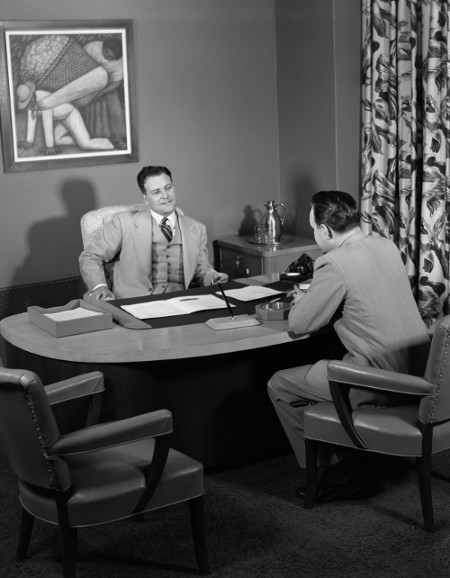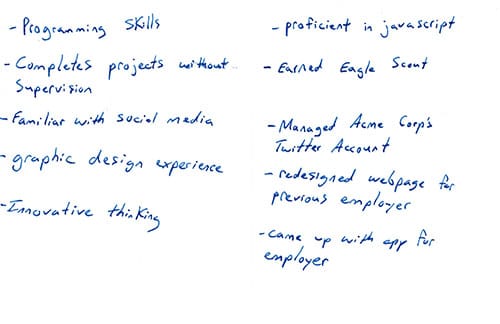
There are two ways to approach a job interview.
With the first, you take a pretty passive stance. You control what you can on your side of things — dressing well, acting confident, trying to give good answers — but a lot of how the interview goes is left up to chance: Is the interviewer effective at asking good questions that allow you to talk about why you’re a great fit for the job? Is he or she feeling tired or fresh? Is the interview long or short? You get whatever kind of interview you happen to walk into.
With the second approach, you take charge of the interview. Rather than hoping you’ll land an eager, experienced interviewer, you make stuff happen for yourself. You talk about the things you need to talk about to make yourself look like the best candidate for the job, even if the interviewer doesn’t directly lead you there. Regardless of the quality of the interview you get, you’re able to offer a complete, persuasive picture of yourself.
How do you control a job interview like this? That’s what we’ll teach you today.
Maximize Your Matchups
In Thinking on Your Feet, Marian K. Woodall argues that there are two ways to control an interview:
- Know what information you must communicate to paint a complete picture (plus additional information which will enhance that picture, if time and circumstances allow).
- Use each question to include a portion of that information, regardless of how much information the question seeks.
Basically, you want to know what a potential employer is looking for in an ideal candidate, match those requirements up with your own experience and traits, and then share those matchups as much as possible during the interview.
Figuring out these matchups is something you should do in the days leading up to the interview. To do so, Woodall recommends creating two columns on a sheet of paper. On one side, list the skills, experiences, aptitudes, preferences, etc. the potential employer is looking for in a candidate. You can figure this out by reviewing and parsing the job description, researching the company, and simply using your powers of deduction. Consider not just the “hard†skills the position calls for, but the attitudes and interests the employer likely wants too. A job at a museum may not require that someone love art, but a passion for it will add value to the position; likewise, being a regular camper may not be mandatory to be hired at an outdoors store, but it can go a long way towards making a candidate more attractive. Finally, keep in mind that there are traits employers are prohibited from advertising for, but desire nonetheless. For example, a construction company may be looking for someone young and strong, while a library prefers someone who’s quiet and mature. List as many traits as possible that the potential employer may be seeking.

On one side of the paper, write the skills/traits an employer is likely looking for in a hire. On the other side, write the skills/traits you possess that match those requirements.
Now in the right-side column, write down any experiences, skills, interests, etc. you possess that match up with each trait or skill you listed on the left side. Making some of these matches will be easy; the employer’s looking for computer programming skills, and you’re adept at javascript and C++. Some may require a little more thought and imagination, though. If you think an employer is looking for someone older, and you’re in your twenties, write down the fact that you’re mature beyond your years due to the fact that you learned patience, responsibility, and organization in taking care of a sick parent while you were growing up. If you think the employer is looking for an energetic young buck, and you’re longer in the tooth, put down the fact that you work out 5X a week and do triathlons. If they’re looking for on-the-job experience, but you’ve just graduated, think of projects, community service, and other things you’ve done that demonstrate the same kind of skills and training.
Review your matchups several times before your interview, and then during, weave the information from the right side column into as many questions as you can. Oftentimes the questions the interviewers ask make this easy — your experience/skills are relevant, and all you have to do is emphasize and highlight the information that best parallels what they’re looking for. You don’t have to always make explicit parallels between the job’s requirements and your own traits, though you can when they ask something like, “What makes you the right person for this job?†“The job description says you’re looking for someone with experience with social media. In my last job, I grew the company’s Facebook page by 10,000 fans.†Or: “I can tell this job requires physical stamina. I still go to the gym 5 times a week and am entering my fifth triathlon this summer. I love physical challenges and enjoy being up and doing things all the time.â€
Peppering your answers with the information from your matchup sheet is an easy way to guide an interview. But what if the interviewer simply isn’t asking questions that give you the opportunity to highlight your strengths?
You can control the questions you get by adjusting them to your advantage.
Turn Questions Around to Your Advantage
In our primer on answering difficult questions, we shared Woodall’s advice on how to respond to challenging queries. The trick is often to adjust or turn the question around in such a way that you can talk about what you want to. Several of her techniques work well for fielding those interview questions that don’t offer the chance to paint yourself in the best possible light:
Refocus the Question
If there’s part of a question you don’t think it’s a good idea to speak to, focus on an aspect that will allow you to highlight one of your matchups. You do that, Woodall writes, by taking “one word from the question (usually not the main topic word) which you are willing to talk about, and [building] a strong, supported response around it.â€
So let’s say a candidate doesn’t have the advanced degree usually required of a position, and is asked:
- “This job requires a strong knowledge of the subject area you’ll be creating exhibits around. Initiative is important as well. In what ways do you exhibit those traits?”
- A good answer could be something like: “My initiative is one of my greatest strengths. I have a passion for diving deep into a subject and I’ve always been able to teach myself new things very quickly. For example, the summer after college, I taught myself both Spanish and French.â€
Build a Bridge
With this technique you build a bridge from what the question asked to what you really want to talk about. This technique is similar to the refocusing strategy, but the break between the content of the question and that of your answer is sharper.
The trick is to bridge to your talking points as smoothly as possible so the transition isn’t too awkward or noticeable. To do this, first acknowledge the significance of the question’s subject, and then look for a logical pivot point towards what you think is the more important factor:
- “Tell me about an on-the-job experience where you managed a project from start to finish.”
- “While on-the-job experience can be important [acknowledging the significance], experience in other areas can be equally valuable [pivoting]. I spent last summer heading up a project to build wells in Africa. I not only had to manage a team and understand differences in the working styles of its members, but also had to navigate cross-cultural differences. The job taught me how to overcome obstacles similar in many ways to the ones it seems like I’ll encounter in this job. For example…â€
- “I see that there’s a year-long gap here on your resume. What were you doing during that time?”
- “I had to take care of some family issues that year. But as you can also see, the work I did both immediately preceding and following that year is directly aligned with the responsibilities of this position. For example, while I was working at Acme Co., I was responsible for…”
Use a Funnel
With the bridge technique, you pivot entirely away from the question’s main subject. But sometimes you just want to narrow the field of discussion, while also encouraging follow-up questions and continued conversation on one certain aspect. With the funnel approach, you can accomplish this by acknowledging the larger issue and then using narrowing words to direct the interviewer’s attention to the area you most want to spotlight:
- “What work experience do you have that makes you a good candidate for this job?â€
- “I have experience in the hospitality business and as a customer service representative, but the experience that most aligns with what you’re looking for is the five years I spent managing an after school program for at-risk youth.â€
Use Your Closer
The final way to take charge of a job interview is to use the final moments/questions to your best advantage.
If the interviewer closes with “Is there anything you’d like to add?†highlight 1-2 of the matchups from your original worksheet that you didn’t get to mention over the course of the interview. “The job description noted that you’re looking for someone with editing experience. Part of my last job included editing the company’s newsletters as well as its blog posts.â€
If they ask, “Do you have any questions for me?†feel free to ask the most effective of the standard variety, but also ask a question that allows you to bring up one of your yet-unmentioned matchups. For example, you can say, “I noticed that the job description indicated that this position requires some graphic design experience. My favorite part of my job at Acme Co. was redesigning their website, and we even won an industry award for it. What kind of graphic design responsibilities will be part of this position?”
The key with what you bring up is to avoid making the interviewer feel like they have subpar interviewing skills, or putting down the company at all. For example, you wouldn’t want to say, “I noticed that the job description mentioned graphic design but you didn’t ask me about my experience in this area.†Or, “I noticed your company’s website is in need of a significant redesign. I have experience in this area and would be happy to help.â€
To review, taking control of a job interview involves:
- Knowing what skills, experiences, attitudes, etc. a potential employer is looking for in a candidate.
- Figuring out how your own skills, experiences, attitudes, etc. match up with those requirements.
- Weaving these matchups into the answers to as many of the questions you’re asked during an interview as possible, even if this means adjusting the question and giving information they didn’t explicitly ask for!
You don’t have to approach an interview passively and hope you get an interviewer and a set of questions that allows you to give a complete picture of why you’re the best man for the job. Come prepared, control how things go, and make the ideal interview happen for yourself!


